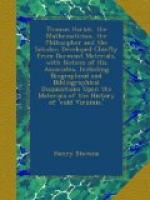In the summer of 1583 Hakluyt thought to go to Newfoundland with Gilbert’s expedition, according to the letter of Parmenius, but fortunately did not go. But in the autumn of the same year Walsingham sent him to Paris nominally as chaplain to the English Ambassador at the French court, Sir Edward Stafford, but really to pursue his geographical investigations into the west and learn what the French and Spanish were doing in these remote regions, and what were their particular claims, resources and trade.
Before his departure for Paris, the ‘Golden Hinde’ had returned to Falmouth with the heavy news of the fate of Gilbert and the consequent certain forfeiture of his patent, notwithstanding it had still some nine months to run. Though Sir Humphrey had taken formal possession of Newfoundland, as no colony was left there, his rights and privileges would lapse as a matter of course.
Western planting now became the talk and fashion. Many projects were hatching for new patents. Raleigh alone succeeded. Hakluyt’s position and circumstances in Paris seem made for the occasion, and he soon found all these western eggs put into his basket. The materials of the several previous writers and of the rival claimants were all apparently thrust upon him. He thus became in 1583-4, though perhaps unconsciously, the mouthpiece of a snug family party all playing into the hands of Raleigh. There were Walsingham, and Sidney, and Carleil, and Leicester, all connected with each other and with Raleigh. Then there were the papers of Sir George Peckham, Edward Hayes, Richard Clarke master of the Delight, and Steven Par-menius, rich alike in hints and facts. The interests of these distinguished persons were by family ties or other influence suddenly merged into a single patent and that Raleigh’s. The papers mostly passed through Raleigh’s hands into Hakluyt’s, who acknowledges himself indebted to him for his chiefest light.




